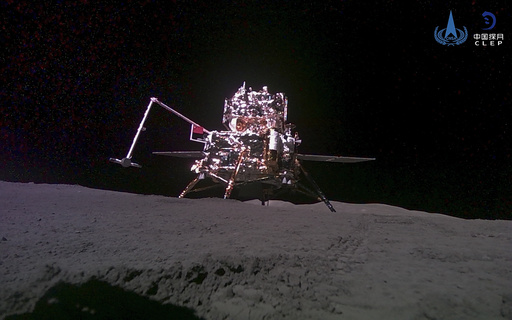BANGKOK (AP) — China’s Chang’e 6 probe returned on Earth with rock and soil samples from the little-explored far side of the moon in a global first.
The probe landed in the Inner Mongolian region in northern China on Tuesday afternoon.
“I now declare that the Chang’e 6 Lunar Exploration Mission achieved complete success,” Zhang Kejian, Director of the China National Space Administration, said in a televised news conference after the landing.
Chinese scientists anticipate the returned samples will include 2.5 million-year-old volcanic rock and other material that scientists hope will answer questions about geographic differences on the moon’s two sides.
The near side is what is seen from Earth, and the far side faces outer space. The far side is also known to have mountains and impact craters, contrasting with the relatively flat expanses visible on the near side.
The probe had landed in the moon’s South Pole-Aitken Basin, an impact crater created more than 4 billion years ago. The samples scientists are expecting will likely come from different layers of the basin, which will bear traces of the different geological events across its long chronology, such as when the moon was younger and had an active inside that could produce volcanic rock.
While past U.S. and Soviet missions have collected samples from the moon’s near side, the Chinese mission was the first that has collected samples from the far side.
“This is a global first in the sense that it’s the first time anyone has been able to take off from the far side of the moon and bring back samples,” said Richard de Grijs, a professor of astrophysics at Macquarie University in Australia.
The moon program is part of a growing rivalry with the U.S. — still the leader in space exploration — and others, including Japan and India. China has put its own space station in orbit and regularly sends crews there.
China’s leader Xi Jinping sent a message of congratulations to the Chang’e team, saying that it was a “landmark achievement in our country’s efforts at becoming a space and technological power.”
The probe left earth on May 3, and its journey lasted 53 days. The probe has drilled into the core and scooped rocks from the surface.
The samples “are expected to answer one of the most fundamental scientific questions in lunar science research: what geologic activity is responsible for the differences between the two sides?” said Zongyu Yue, a geologist at the Chinese Academy of Sciences, in a statement issued in the Innovation Monday, a journal published in partnership with the Chinese Academy of Sciences.
China in recent years has launched multiple successful missions to the moon, collecting samples from the moon’s near side with the Chang’e 5 probe previously.
They are also hoping that the probe will return with material that bear traces of meteorite strikes from the moon’s past. That material could shed light on the solar system’s early days. There’s a theory that the moon acted as a vaccum cleaner of sorts, attracting all the meteorites and debris in the system’s earlier era so that they didn’t hit Earth, said de Grijs, who is also executive director at the International Space Science Institute — Beijing.
China has said it plans to share the samples with international scientists, although it did not say exactly in which countries.
___
AP video producer Olivia Zhang contributed to this report.
This website uses cookies so that we can provide you with the best user experience possible. Cookie information is stored in your browser and performs functions such as recognising you when you return to our website and helping our team to understand which sections of the website you find most interesting and useful.
